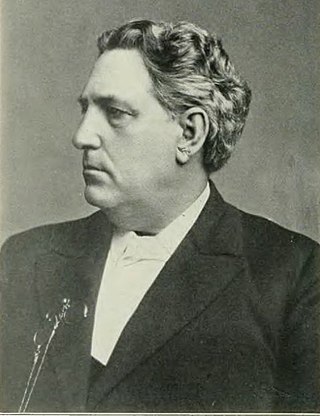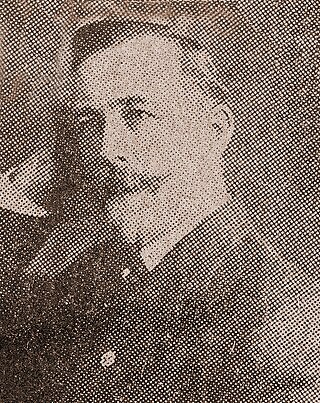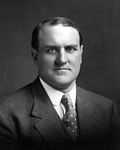
Matthew Stanley Quay was an American politician of the Republican Party who represented Pennsylvania in the United States Senate from 1887 until 1899 and from 1901 until his death in 1904. Quay's control of the Pennsylvania Republican political machine for almost twenty years made him one of the most powerful and influential politicians in the country. As chair of the Republican National Committee and thus party campaign manager, he helped elect Benjamin Harrison as president in 1888. He was also instrumental in the 1900 election of Theodore Roosevelt as vice president.

John Kinley Tener was an Irish-born American politician and Major League Baseball player and executive. He served as the 25th governor of Pennsylvania from 1911 until 1915. A Republican, he had previously served as a U.S. Representative for Pennsylvania's 24th congressional district.

The 2006 Pennsylvania gubernatorial election was held on November 7, 2006, and included the races for the governor of Pennsylvania and lieutenant governor of Pennsylvania. Incumbent Democratic governor Ed Rendell successfully ran for re-election. Pennsylvania's first female lieutenant governor, Catherine Baker Knoll, was also running for re-election.

Boies Penrose was an American politician from Philadelphia, Pennsylvania, who served as a Republican member of the United States Senate for Pennsylvania from 1897 to 1921. He served as a member of the Pennsylvania House of Representatives for the Philadelphia County district in 1885. He served as a member of the Pennsylvania State Senate for the 6th district in 1897 and as President pro tempore of the Pennsylvania Senate from 1889 to 1891.

The 1998 Pennsylvania gubernatorial election was held on November 3, 1998. The candidates were incumbent Republican Tom Ridge, Democrat Ivan Itkin, Constitutionalist Peg Luksik and Libertarian Ken Krawchuk. Ridge, a popular moderate, won with 57 percent of the votes cast.

The 1994 Pennsylvania gubernatorial election was held on November 8, 1994. The incumbent governor, Bob Casey, Sr. (Democrat), was barred from seeking a third term by the state constitution. The Republican Party nominated Congressman Tom Ridge, while the Democrats nominated Mark Singel, Casey's lieutenant governor. Ridge went on to win the race with 45% of the vote. Singel finished with 39%, and Constitution Party candidate Peg Luksik finished third, garnering 12% of the vote.

William Harvey Berry was an American politician who served as Mayor of Chester, Pennsylvania, for one year in 1905 and as the Pennsylvania State Treasurer from 1906 to 1908. As Treasurer, Berry identified misappropriations in the graft scandal related to furnishing of the Pennsylvania State Capitol. Berry was President of the Berry Engineering Company, worked as Collector of the Port of Philadelphia and authored multiple books on economic policy.

John W. Slayton (1863–1935) was an American socialist lecturer and politician. He is best remembered as one of the Socialist Party of America's leading propagandists in the Eastern United States during the decade of the 1910s.

The Ohio general elections, 2010 were held on November 2, 2010, throughout Ohio. Primary elections took place on May 4, 2010.

The 1978 Pennsylvania gubernatorial election was held on November 7, 1978. Incumbent Governor Milton Shapp was constitutionally ineligible to run for a third consecutive term in office. Republican Dick Thornburgh defeated Democrat Pete Flaherty in the general election.

The 1970 Pennsylvania gubernatorial election was held on November 3. Democrat Milton Shapp challenged incumbent Republican Lieutenant Governor Ray Broderick.

The 1966 Pennsylvania gubernatorial election was held on November 8. Republican Ray Shafer, the state's incumbent Lieutenant Governor, was elected to the state's highest office after holding off a charge from future governor Milton Shapp.

The 1954 Pennsylvania gubernatorial election was held on November 2. In what is considered a crucial realigning election for the state, Democratic State Senator George M. Leader defeated Republican incumbent Lieutenant Governor Lloyd Wood, becoming the first Democrat to be elected governor since 1934.

The 1946 Pennsylvania gubernatorial election was held on November 5, 1946. Republican Party nominee James H. Duff defeated Democratic Party nominee John S. Rice to become Governor of Pennsylvania. As of 2025, this was the last time Philadelphia County voted for the Republican candidate.

The 1930 Pennsylvania gubernatorial election occurred on November 4, 1930. Incumbent Republican governor John Stuchell Fisher was not a candidate for re-election. Republican candidate and former governor Gifford Pinchot defeated Democratic candidate John M. Hemphill to win a second, non-consecutive term as Governor of Pennsylvania.

The Ohio general elections, 2014 were held on November 4, 2014, throughout Ohio, with polls opened between 6:30AM and 7:30PM. The close of registration for electors in the primary election was April 7, 2014, and the primary election day took place on May 6, 2014.

A general election was held in the U.S. state of Illinois on November 4, 2014. All of Illinois' executive officers were up for election as well as a United States Senate seat, and all of Illinois' eighteen seats in the United States House of Representatives. Primary elections were held on March 18, 2014.

The 1973 New Jersey Senate elections were held on November 6. The result of the elections were large gains for the Democratic Party, which won control of the Senate. The party picked up twelve seats. This election marked the first time since 1967 that Democrats controlled the State Senate.

The 2022 Pennsylvania gubernatorial election was held on November 8, 2022, to elect the governor and lieutenant governor of Pennsylvania. Democratic state attorney general Josh Shapiro defeated Republican state senator Doug Mastriano to win his first term in office. Shapiro succeeded Democratic incumbent Tom Wolf, who was term limited.

The Liberal Party of Pennsylvania is a third party in Pennsylvania founded as the Keystone Party of Pennsylvania in 2022, rebranding to the Liberal moniker in 2024, with a focus on political solutions through the electoral process and classical liberalism.
























